| Yukiko SHIMOOKA, D.Scü@ |
Research Staff
Laboratory of Human Evolution Studies
mailing address: Graduate School of Science, Kyoto University
Kitashirakawa Oiwakecho, Sakyo, Kyoto 606-8502
e-mail:
Japanese page is here!
| Yukiko SHIMOOKA, D.Scü@ |
| Research | |
| Socioecological study on wild spider monkeys | |
üíü@Field work at CIEM (La Macarena, Colombia) was conducted in 1996-2002, to clarify the social structure of wild long-haired spider monkeys (Ateles belzebuth). Spider monkeys have a fission-fusion social organization in which individuals of the group were dispersed over the 2km2 home range forming smaller parties. Their immigration pattern is patrilineal, in which females move between groups and males remain in their natal group. These two characteristics are quite similar with those of chimpanzees. Since 1997, we have habituated and identified four groups of wild spider monkeys around the Chamuza camp of CIEM. We have examined the preference in party formation, the relation between environment (fruit availability) and party size, the sex differences in ranging patterns, the function of long-loud calls. Study periodüF1996ü|2002 Study period: 2005- |
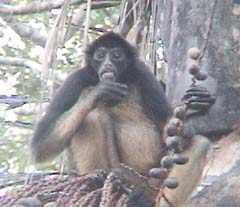 Adult female "Rico" eating palm fruitsüiOenocarpus bataua) 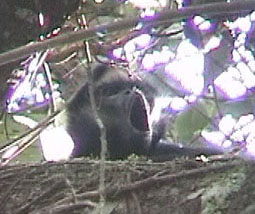 Adult male "Kakeru" uttering a long-loud call that reachs 500m |
| Reconciliational behavior of Japanese Macaques at Kinkazan Island | |
I studied "rocking embrace behaviour"of Japanese macaques in Kinkazan Island, and found that it functions to relax the tesity arising between individuals. When they engage in grooming, they sometimes fail to change the groomee and the groomer. When a grooming series was disrupted, they began to embrace with each other with large movement, emitting small vocalization "girney". After this movement, they restarted grooming soon. Study period: 1997 |
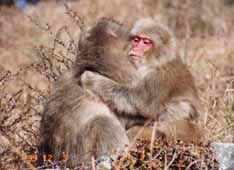 Japanese macaques in "rocking enbrace behaviour" Please put the cursor on and off the picture. |
| Subgrouping of Japanese Macaques at Kinkazan island | |
Usually, Japanese macaques form a cohesive group and their movement is totally coordinated. But the group is sometimes splitted into two, and this phenomenon is called as "subgrouping". Subgrouping of Japanese macaques are usually observed when the group is too large (>100 individuals) or when the group is going to fission into two different groups. But in Kinkazan Island, Japanese macaque do subgrouping quite often since 1990's, although the group size is normal (about 30 individuals) and the group has been stable for more than ten years. I and colleagues followed different individuals of the same group simultaneously and recorded their position using GPS. And we analyzed their movement and clarified the seasonal difference in the frequency of subgroupiung and the situation sit occured. Study periodüF2003-2004 |
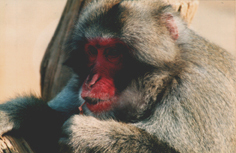 Adult male of Japanese macaque.  A young female Japanese macaque in snow |
| Chimpanzee vocalizations at feeding trees | |
| Chimpanzees have various types of vocalization and each type of vocalization
is produced at different context (Goodall, 1986). Among variable vocalizations,
food-grant and pant-hoot are produced in association with feeding (Marler
and Tenaza, 1986)üBI examined the influence of quantity of food at feeding
trees on calling behavior of wild chimpanzees, especially on the production
of food-grunt. Study periodüF2005 (Jan.-Feb.) |
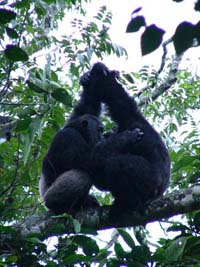 Male chimpanzees grooming with each other. |
| Publications and Presentations | |
| üíPapers (only in English) | |
|
üť SHIMOOKA Y. (2005) Sexual Differences in Ranging of Ateles belzebuth belzebuth at La Macarena, Colombia. International Journal of Primatology Vol. 26(2)
385-406. üť SHIMOOKA, Y (2003) Seasonal Variation in Association Patterns of Wild Spider Monkeys (Ateles belzebuth belzebuth) at La Macarena, Colombia. Primates 44: 83-90 üť KOBAYASHI, M., SHIMOOKA, Y., IZAWA, K. (1999) Frugivoreü]dispersed Seedling of Milpeso Palm, Oenocarpus bataua Mart., in the Neotropical Rain Forest of La Macarena, Colombia. Field Studies of Fauna and Flora La Macarena Colombia, vol.13 pp.41-46 |
|
| üíPresentations (only in English) | |
|
üť YAMAGIWA, J. and SHIMOOKA, Y. (2005) Life history tactics in female dispersal primates. Kyoto conference -Delphinid and Primate Social Ecology: A Comparative Discussion. Kyoto, Japan üť SHIMOOKA, Y., Sugiura, H. and Tsuji, Y. (2005) Subgrouping of wild Japanese macaques on Kinkazan Island - simultaneous observation on two individuals using GPS. ü@Kyoto conference -Delphinid and Primate Social Ecology: A Comparative Discussion. Kyoto, Japan üť SHIMOOKA, Y., Sugiura, H. and Tsuji, Y. üi2005üj Subgrouping of wild Japanese macaques on Kinkazan Island - simultaneous observation on two individuals using GPS. IX International Mammalogical Congress. Sapporo, Japan. üť KODA, H., SHIMOOKA, Y. and Sugiura, H. (2005) Do wild Japanese macaques modify their rate of contact calls in response to the environment? IX International Mammalogical Congress. Sapporo, Japan. üť SHIMOOKA, Y. (2004) Long call and its effect on grouping pattern in wild spider monkeys. African Great Apes: Evolution, Diversity, and Conservation. Kyoto. üť SHIMOOKA, Y. (2002) Ranging patterns of spider monkeys (Ateles belzebuth) at La Macarena, Colombia. XIXth IPS Congress, Beijing (International Convention Center), China. üť KOBAYASHI, M., SHIMOOKA, Y. IZAWA, K. (1999) "Frugivoreü]dispersed Seedling of Milpeso Palm, Oenocarpus bataua Mart., in the Neotropical Rain Forest of La Macarena, Colombia." The International Symposium: Plant Population Biology and Evolution: New Perspective towards a New Century. Tokyo, Japan. |
|
Last update: 2006/04/10 |
|
| Kyoto University Links Lab. Human Evolution StudiesübDep. Zoology, Graduate Schoolof Science übPrimate Research Institute üb Kyoto Univ. |
|